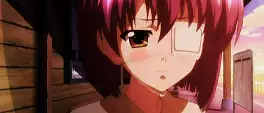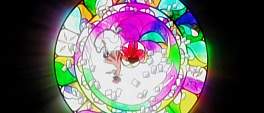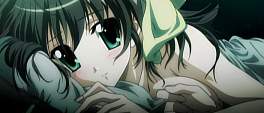



It is easy to fall in love with Bakemonogatari when looking at screenshots because for the most part, a collection of screenshots is all you receive with it - the most recent studio SHAFT / Akiyuki Shinbo series. If phrases were associated to anime, Bakemonogatari's would be "style over substance". So far does it take this maxim that it's difficult to describe any point where one feels connected or even mildly interested in the glossy puppets that fornicate with the bold colour palette.
from ice-queen cynicism to obnoxious trollop without missing a step
The story, as much as there is one, concerns Araragi who acts as a paranormal busy body for girls - ranging in age from barely legal to certainly illegal - suffering from a plethora of supernatural ailments. To aid him he regularly consults a destitute punk living in a derelict school with a outwardly pre-teen female vampire. The mythos and character back-stories are the sharpest part of the series and the afflictions suffered by the protagonists are certainly above the usual monster of the week fare, although this is perhaps thanks to the light novel source material than the anime adaptation. SHAFT and Shinbo plot their usual course and drench the series in faux abstract visuals - implying there is more meaning than is available and consequently presenting something vapid and soulless more than modern and engaging. Sudden cuts to single colour title cards start off as eccentric but quickly become a crutch to prop up the wildly varying production.
Read the rest of this entry




Given such an auspicious and confusing opening three episodes, it would have been easy for ef to fall into obscurity and abstraction with deep symbolism and obscured plot; thankfully this is not the case and the series manages to make the absurdly stylistic symbolism part of itself while still a sometimes unique, not wholly original story which ends well at a petite twelve episodes.
the grayscale visions of Hiro, the stained glass technicolour of Chihiro and the sunset beaches for everyone
In between the astounding opening and changing ending are two stories: one about a high school boy trying to find colour in his world while trying to deal with the affections of two girls, one overt and another covert; the other is about a girl whose memory lasts only a scant thirteen hours before events begin slipping away and her relationship with a boy she meets at an abandoned train station. The plot may sound akin to an atypical dating-sim territory but the storytelling is first rate and deftly draws one into the world and its characters. The supernatural elements that nagged the opening episodes are present but downplayed; the ephemeral figure of a long haired woman who imparts advice to all of the central characters and then vanishes is never explained even slightly, the same with the silent, world weary caretaker of the memory-challenged protagonist. The only time these elements are brought to the fore is in the final moments of the series, hinting more at a desire for a second season rather than anything that would affect the first.
Read the rest of this entry




With signature aplomb, SHAFT take up art-duties with ef - a tale of memories and craft a typically stylish and coy introduction to an intriguing and melodramatic series. Long shadows and open skies, stark lines and silhouetted profiles, the art direction obscures the sedate story and mundane characters but the potential for things much greater is too enticing to pass up.
the characters [...] are sometimes infuriatingly obtuse, communicating through enigmatic monologues or understated emotions
ef - a tale of memories pitches itself somewhere in between school drama and supernatural, School Days and Sola; it has the straight faced drama of School Days but more playful, with the fantasy hints of Sola except less blatant. The first episode can best be described as confusing: cutting back and forth between full colour, grayscale, black and white and all points in between seemingly at random then leaping forwards or backwards through time with nary a keystone to right oneself. It conjures up thoughts of Soultaker and the premise being the weirdness rather than coherence; thankfully these thoughts are allayed in the second and third episodes which deftly sculpt the story, rarely allowing itself to be pre-empted by the viewer. It doesn't so much tone-down the oddness as spread it more thinly. The abandon shown for chronology is more telling as certain characters and traits are in one arc and not the other, wordlessly foreshadowing momentous events on the horizon.
Read the rest of this entry











